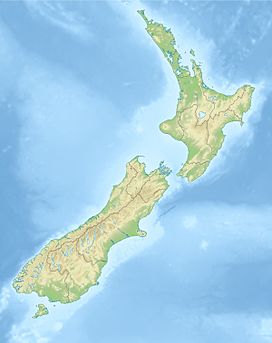Mt Taranaki
| Mount Taranaki | |
|---|---|
| Mount Egmont | |

View of Taranaki from Stratford, showing Fanthams Peak on the southern flank
|
|
| Highest point | |
| Elevation | 2,518 m (8,261 ft) |
| Prominence | 2,308 m (7,572 ft) |
| Listing |
Ultra New Zealand #65 |
| Coordinates | 39°17′47″S 174°03′53″E / 39.29639°S 174.06472°ECoordinates: 39°17′47″S 174°03′53″E / 39.29639°S 174.06472°E |
| Geography | |
|
North Island, New Zealand
|
|
| Topo map | NZMS 169 Egmont National Park |
| Geology | |
| Mountain type | Stratovolcano |
| Last eruption | 1854 |
| Climbing | |
| First ascent | Ernst Dieffenbach & James Heberly, 1839 |
| Easiest route | Mount Taranaki Summit Track (trail) |
Mount Taranaki, or Mount Egmont, is an active but quiescent stratovolcano in the Taranaki region on the west coast of New Zealand's North Island. Although the mountain is more commonly referred to as Taranaki, it has two official names under the alternative names policy of the New Zealand Geographic Board. The 2,518 metres (8,261 ft) mountain is one of the most symmetrical volcanic cones in the world. There is a secondary cone, Fanthams Peak (Māori: Panitahi), 1,966 metres (6,450 ft), on the south side. Because of its resemblance to Mount Fuji, Taranaki provided the backdrop for the movie The Last Samurai.
For many centuries the mountain was called Taranaki by Māori. The Māori word tara means mountain peak, and naki is thought to come from ngaki, meaning "shining", a reference to the snow-clad winter nature of the upper slopes. It was also named Pukehaupapa and Pukeonaki by iwi who live in the region in ancient times.
Captain Cook named it Mount Egmont on 11 January 1770 after John Perceval, 2nd Earl of Egmont, a former First Lord of the Admiralty who had supported the concept of an oceanic search for Terra Australis Incognita. Cook described it as "of a prodigious height and its top cover'd with everlasting snow," surrounded by a "flat country ... which afforded a very good aspect, being clothed with wood and verdure".
When Marc-Joseph Marion du Fresne made landfall off Taranaki on 25 March 1772 he named the mountain Pic Mascarin. He was unaware of Cook's earlier visit.
...
Wikipedia

